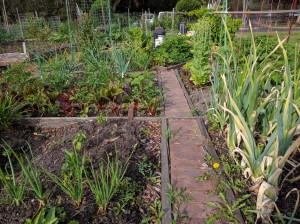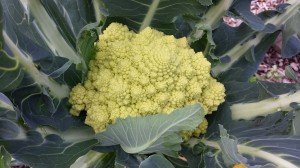Shen joined the garden in Feb 2014, starting with half plot near the shed.
She moved to a full plot in late March 2016.
The plot is a working in progress, for example, she is still finding time to install a compost bin.
When Shen inherited the full plot, she cleared the plot in stages due to the existing plantings left behind by the previous gardener.
There were tomatoes, chillies and pumpkins and she wanted to harvest those produce.
While she was working on clearing the veggie patch, her decision on what to plant was based on three things:
o the space available at the time,
o the type of plants suitable to be planted,
o and to including plants, such as rhubarb & asparagus, that will be transplanted from previous plot.
Shen is good at planning ahead and organizes where to plant what.
To plan and design her veggie patch, Shen started writing down a list of vegetables she wants to grow and eat – no point to grow something that you don’t eat.
Then she sketched up the plot. This way she understood the space available.
Last step of the planning is to divide the plot to accommodate all the plants.
Companion planting has been considered where possible, eg. Carrots grown under bean trellis and eggplants grown next to beans.
Important to note that the sketch is only used as a starting point.
Planting changes can be made based on either seedling germination failure or interest in other vegetables to try growing.
The things Shen also took into consideration when laying out the plot are:
o sun angles for maximise direct sunlight and
o overall slope of the plot and how water runs and stays
Of course, there were times that things didn’t work out.
For example, Shen did not consider the tall trees planted outside the garden which cast a shadow over plants.
Due to the low sun angle in winter, half the plot is in shade by 1pm.
And although the overall slope of plot was considered during plot design, Shen found out that with the constant rainfall, there are pockets in the plot that are wetter than expected, resulting in delayed plantings, afraid of rot i.e. potatoes and beans
It will take time for Shen to experiment and try different things to overcome these challenges.
Shen’s organic practices includes
o Avoid using snail baits by using crushed eggshells around plants to deter snails and slugs
o Planted green manure crops to be dug into soil to increase organic matter and encourage worms to soil
o Chopped up unused part vegetables, such as cabbage and old lettuce leaves, and turned them into the soil. Of course, diseased parts are put into rubbish bin
o Does not use plastic plant labels but uses sticks found around the garden as plant markers. She uses these ‘organic’ plant markers in conjunction with the sketch of the plot planting layout so that she remembers where the seeds and seedlings are.
For Shen, gardening is all about experimenting and having fun.
The amount of harvest is not the most important.
Gardening at the community garden has become very much a social gathering and she has made many friends here.


